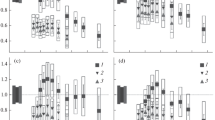Abstract
Hadronization of quark–gluon plasma is one of the most discussed problems in modern high-energy physics. It has been found in the PHENIX experiment (2002) that the ratio of (anti)proton yields to \({{\pi }^{ \pm }}\)-meson yields in Au + Au collisions at the energy of 130 GeV (and later at 200 GeV) is anomalously large as compared to proton–proton collisions. The only model capable of explaining this anomaly is one of the hadronization models based on parton recombination. Measurements of \({{\pi }^{ \pm }},~{{K}^{ \pm }}\), and \({{\left( {p + \bar {p}} \right)} \mathord{\left/ {\vphantom {{\left( {p + \bar {p}} \right)} 2}} \right. \kern-0em} 2}\) in asymmetric Cu + Au collisions at the energy of 200 GeV are reported, which have been performed to study the effect of collision geometry on production of charged hadrons.



Similar content being viewed by others
REFERENCES
K. Adox et al. (PHENIX Collab.), “Formation of dense partonic matter in relativistic nucleus–nucleus collisions at RHIC: Experimental evaluation by the PHENIX Collaboration,” Nucl. Phys. A 757, 184–283 (2005).
R. Fries, V. Greco, and P. Sorensen, “Coalescence models for hadron formation from quark-gluon plasma,” Ann. Rev. Nucl. Part. Sci. 58, 177–205 (2008).
T. Chujo (PHENIX Collab.), “Results on identified hadrons from the PHENIX experiment at RHIC,” Nucl. Phys. A 715, 151–160 (2003).
K. Adox et al. (PHENIX Collab.), “PHENIX detector overview,” Nucl. Instrum. Methods Phys. Res., Sect. A 499, 469 (2005).
M. Harrison, T. Ludlam, and S. Ozaki, “RHIC project overview,” Nucl. Instrum. Methods Phys. Res., Sect. A 499, 235 (2003).
A. Adare et al. (PHENIX Collab.), “Spectra and ratios of identified particles in Au + Au and d + Au collisions at \(\sqrt {{{s}_{{NN}}}} \) = 200 GeV,” Phys. Rev. C 88, 024906 (2013).
I. Mitrankov, “Phi meson measurements in Cu + Au collisions at 200 GeV and in U + U collisions at 192 GeV,” Proc. Sci. 345, 0108 (2018).
A. Ya. Berdnikov, Ya. A. Berdnikov, D. O. Kotov, D. M. Larionova, M. M. Larionova, and Iu. M. Mitrankov, “Measuring phi mesons in p + Au and He + Au collisions at 200 GeV,” Bull. Russ. Acad. Sci.: Phys. 84, 1533 (2020).
Funding
The research is partially funded by the Ministry of Science and Higher Education of the Russian Federation under the strategic academic leadership program “Priority 2030” (Agreement 075-15-2021-1333).
Author information
Authors and Affiliations
Corresponding author
Additional information
Translated by M. Potapov
Rights and permissions
About this article
Cite this article
Larionova, D.M., Berdnikov, Y.A., Berdnikov, A.Y. et al. Charged Hadron Production in Cu + Au Collisions at 200 GeV in the PHENIX Experiment. Phys. Part. Nuclei 53, 261–264 (2022). https://doi.org/10.1134/S1063779622020460
Received:
Revised:
Accepted:
Published:
Issue Date:
DOI: https://doi.org/10.1134/S1063779622020460




